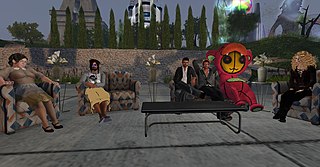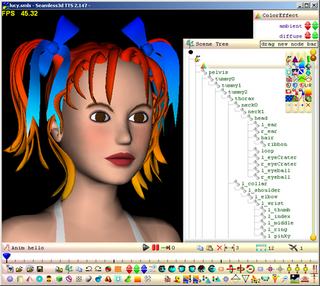
VRML is a standard file format for representing 3-dimensional (3D) interactive vector graphics, designed particularly with the World Wide Web in mind. It has been superseded by X3D.
X3D is a set of royalty-free ISO/IEC standards for declaratively representing 3D computer graphics. X3D includes multiple graphics file formats, programming-language API definitions, and run-time specifications for both delivery and integration of interactive network-capable 3D data. X3D version 4.0 has been approved by Web3D Consortium, and is under final review by ISO/IEC as a revised International Standard (IS).
The Khronos Group, Inc. is an open, non-profit, member-driven consortium of 170 organizations developing, publishing and maintaining royalty-free interoperability standards for 3D graphics, virtual reality, augmented reality, parallel computation, vision acceleration and machine learning. The open standards and associated conformance tests enable software applications and middleware to effectively harness authoring and accelerated playback of dynamic media across a wide variety of platforms and devices. The group is based in Beaverton, Oregon.
COLLADA is an interchange file format for interactive 3D applications. It is managed by the nonprofit technology consortium, the Khronos Group, and has been adopted by ISO as a publicly available specification, ISO/PAS 17506.

The metaverse is a loosely defined term referring to virtual worlds in which users represented by avatars interact, usually in 3D and focused on social and economic connection.
Humanoid Animation (HAnim) is an approved ISO and IEC standard for humanoid modeling and animation. HAnim defines a specification for defining interchangeable human figures so that those characters can be used across a variety of 3D games and simulation environments.
Demicron WireFusion an authoring tool for creating interactive Web3D presentations. A typical work flow consists of loading a 3D model, configuring/optimizing the 3D model and lastly adding widgets and logic to the presentation. The 3D model is created in a 3D modeling program, like 3DS Max, Maya or any other 3D modeling program that can export as X3D or VRML. The resulting presentations can run in browsers supporting Java 1.1+.
An image file format is a file format for a digital image. There are many formats that can be used, such as JPEG, PNG, and GIF. Most formats up until 2022 were for storing 2D images, not 3D ones. The data stored in an image file format may be compressed or uncompressed. If the data is compressed, it may be done so using lossy compression or lossless compression. For graphic design applications, vector formats are often used. Some image file formats support transparency.
Web3D Consortium is an international not-for-profit, member-funded industry consortium, originally founded in 1997. Web3D Consortium members from governmental, nonprofit and research organizations worldwide, including working alongside individual professional members to collaborate in a consensus process and encouraging development and implementation of open standards for 3D content and services.

Mark D. Pesce is an American-Australian author, researcher, engineer, futurist and teacher.
Flux was a software suite released by Media Machines which consisted of Flux Player and Flux Studio.

Seamless3d is an open-source 3D modeling software available under the MIT license.
Web3D, also called 3D Web, is a group of technologies to display and navigate websites using 3D computer graphics.
3DMLW is a discontinued open-source project, and a XML-based Markup Language for representing interactive 3D and 2D content on the World Wide Web.

Blaxxun Interactive, originally named "Black Sun Interactive", was one of the first companies to develop a 3D community platform designed for the Internet using VRML and highly scalable multi-user server environments.

O3D is an open-source JavaScript API created by Google for creating interactive 3D graphics applications that run in a web browser window or in a XUL desktop application. O3D may be crafted for use in any application area; however, it is geared towards games, advertisements, 3D model viewers, product demos, simulations, engineering applications, control and monitoring systems, and massive online virtual worlds. O3D is currently in Google's incubation lab, and was originally built as a web browser plugin. Since 2010, O3D is a JavaScript library implemented on top of WebGL.

WebGL is a JavaScript API for rendering interactive 2D and 3D graphics within any compatible web browser without the use of plug-ins. WebGL is fully integrated with other web standards, allowing GPU-accelerated usage of physics, image processing, and effects in the HTML canvas. WebGL elements can be mixed with other HTML elements and composited with other parts of the page or page background.
VREAM, Inc. was a US technology company that functioned between 1991 and 1996. It was one of the first companies to develop PC-based software for authoring and viewing virtual reality (VR) environments.

glTF is a standard file format for three-dimensional scenes and models. A glTF file uses one of two possible file extensions: .gltf (JSON/ASCII) or .glb (binary). Both .gltf and .glb files may reference external binary and texture resources. Alternatively, both formats may be self-contained by directly embedding binary data buffers. An open standard developed and maintained by the Khronos Group, it supports 3D model geometry, appearance, scene graph hierarchy, and animation. It is intended to be a streamlined, interoperable format for the delivery of 3D assets, while minimizing file size and runtime processing by apps. As such, its creators have described it as the "JPEG of 3D."
Spatial is a Unity-powered UGC gaming platform that enables developers to publish and monetize multiplayer games across web, mobile, and VR. Spatial focuses on games developed using the Unity game engine and the C# programming language. The company is headquartered in New York.








